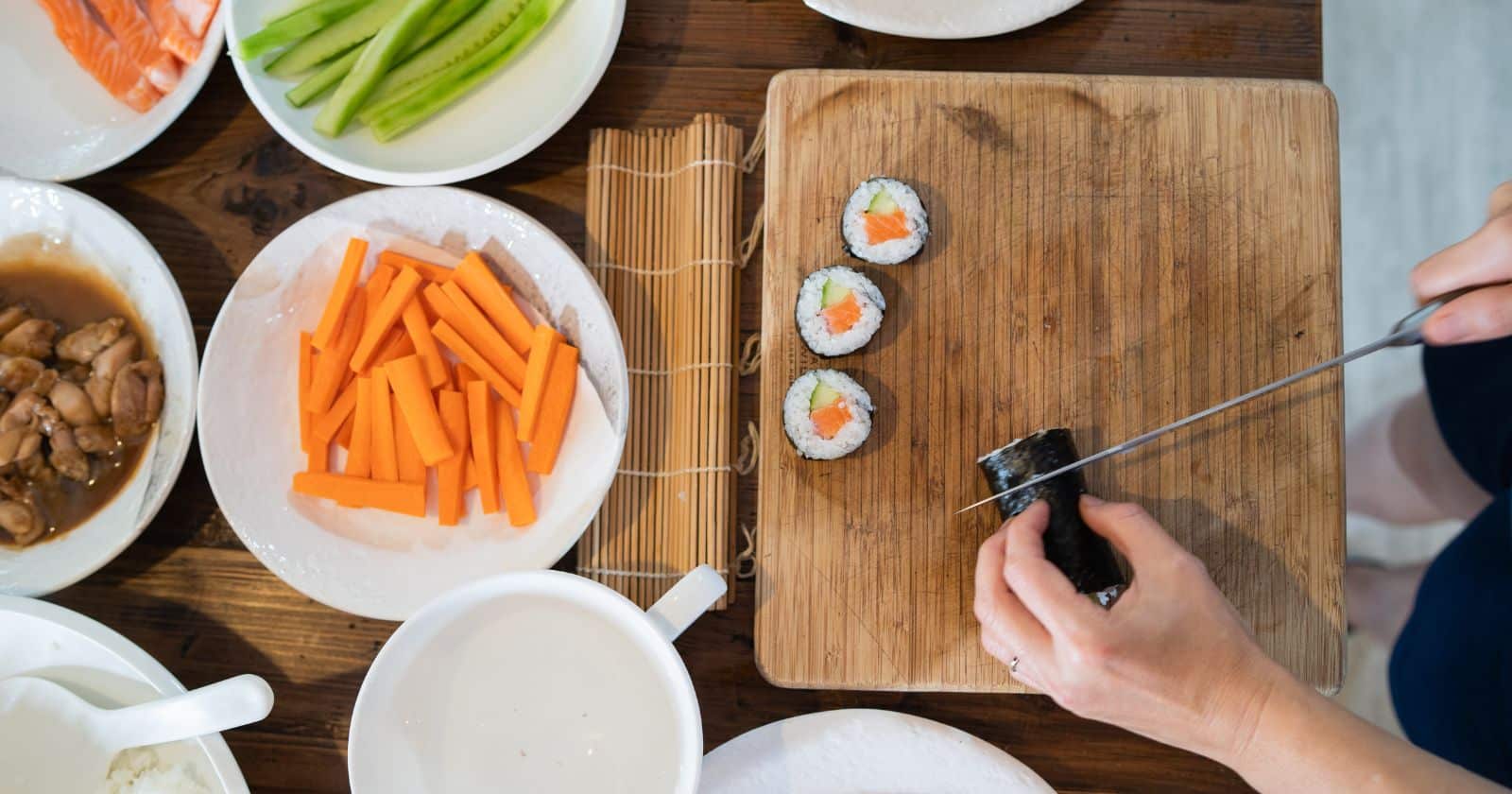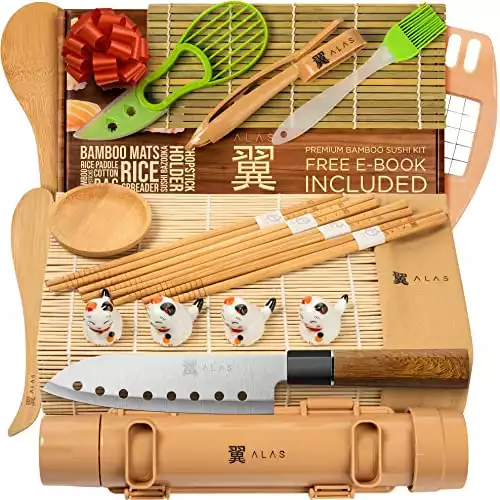Sushi is one of the most beloved foods around the world. It’s delicious, healthy, and easy to make at home. But is it expensive to make sushi at home?
Making sushi at home can be relatively inexpensive. The main costs associated with making sushi at home are the ingredients, such as sushi rice, rice vinegar, sugar, salt, nori, and fillings. The cost of these ingredients can vary, but on average you can expect to pay around $17 – $36 for ingredients that you can make approximately 10-15 sushi rolls.
Equipment costs, such as a sushi mat, knife, and wooden sushi rice bowl, can vary, but on average you can expect to pay around $50 – $160 or opt out for sushi making kit for about $30-50.
The good news is you don’t need to invest in expensive equipment to make sushi at home; it’s possible to use household items such as a plastic wrap, or a chef’s knife if you don’t have the right tools.
Overall, making sushi at home can be a cost-effective option if you plan ahead and purchase ingredients in bulk. Ingredients and equipment that are left after making sushi still can be used for other dishes.
In this article, I’ll break down the costs of making sushi at home, show you how to make it on a budget, and substitute items for a more affordable alternative.
Ingredients
The ingredients are one of the most significant expenses when making sushi at home. The good news is that you don’t need many ingredients to make sushi.
The essential ingredients include:
- Rice
- Rice vinegar
- Sugar
- Salt
- Nori (dried seaweed)
- Fillings of your choice (such as fish, vegetables, and avocado)
When buying ingredients, it’s best to buy them in bulk. This will save you money in the long run. For example, buying a large bag of rice will be cheaper than buying multiple small loads.
Everything excerpt fillings can store well for a year. So, buy in bulk and save! (Or if you’re still learning how to make sushi, you can buy smaller quantities).
Here are how to choose the right ingredients for making sushi:
Rice
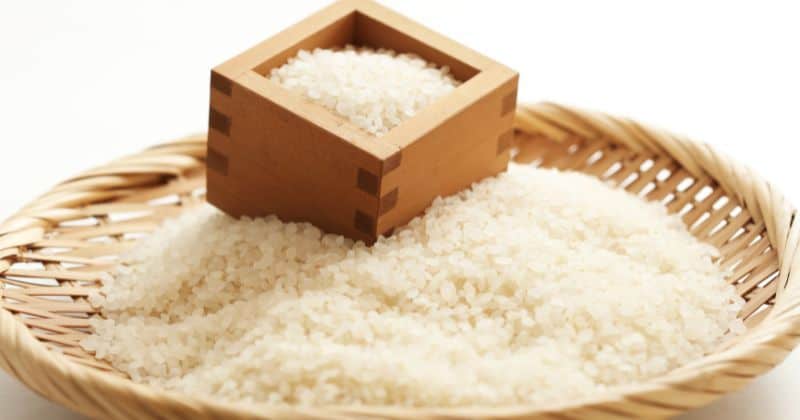
Choosing rice is essential when making sushi. You’ll want to buy short-grain or medium-grain rice, a starchy variety that gives sushi its iconic texture. Short-grain or medium-grain rice also helps the pieces of sushi stay together while they are rolled up.
When you’re in the grocery store, you can look for rice labeled as “sushi” grade; this means that it’s of the highest quality and is perfect for sushi. Japanese rice is often the preferred type, but you can also use other varieties.
Be sure to avoid using long-grain or basmati rice as they are not suitable for sushi, it is not sticky enough, and the pre-seasoned or cooked rice will ruin your sushi.
Rice Vinegar

Look for rice vinegar made from rice, water, and koji (a mold used to ferment the rice). These traditional ingredients make rice vinegar and will give you the best taste. The rice vinegar should not contain any fat or has been distilled or contains added alcohol, as it will affect the taste and texture of the sushi rice.
If you’re in a hurry, some rice vinegar has labeled “rice vinegar for sushi,” and it is good quality that you can find in the store (I found Marukan and Nakano brands can buy from Amazon).
Sugar

Use granulated white sugar or caster sugar; this sugar will dissolve quickly and evenly in the rice vinegar, which is crucial for seasoning sushi rice.
Avoid using raw or brown sugar as it will not dissolve as evenly and can cause clumps in the sushi rice. Additionally, avoid using artificial sweeteners as they will not provide the same taste and texture as sugar.
Salt

For making sushi, you’ll want to use sea salt or kosher salt. These types of salts will dissolve quickly and evenly in the rice vinegar mixture.
Avoid using coarse salt as it will not dissolve as evenly and can cause clumps in the sushi rice also avoid using iodized table salt, as it contains added iodine and anti-caking agents which can affect the taste and texture of the sushi rice.
Nori
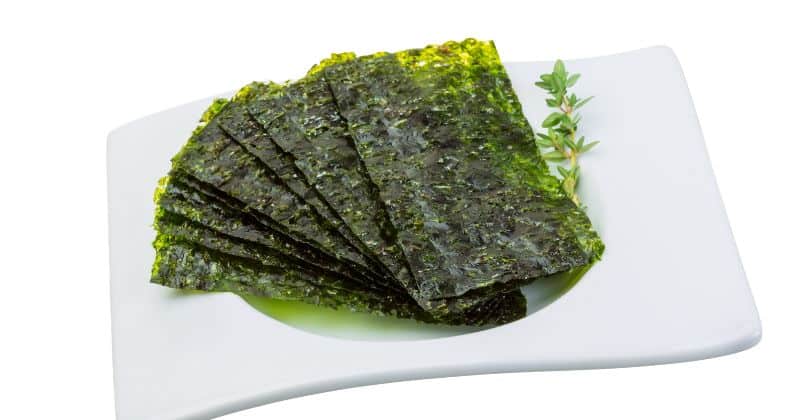
Look for nori that is dark green and has a glossy surface, this indicates that it is fresh and of good quality.
Avoid using nori that is yellow or brown, as it may be old or exposed to light, which can affect the taste and texture of the sushi.
Fillings
When it comes to making sushi, the fillings you choose can make a big difference in the taste and cost of your sushi. Here’s a breakdown of how to choose fillings for sushi, including affordable options, premium choices
Affordable Options:
- Avocado
- Cucumber
- Carrots
- Bell peppers
- Tofu
- Egg omelet
- Scallions
These options are relatively inexpensive and can be found at most grocery stores. They are also versatile and can be used in a variety of sushi rolls. On average, these fillings cost around $0.5-$2 per roll.
Premium Choices:
- Tuna
- Salmon
- Yellowtail
- Shrimp
- Crab
- Lobster
- Eel
These options tend to be more expensive than affordable options, but they offer a higher quality taste and texture. They are often found at specialty seafood markets or sushi restaurants. On average, these fillings cost around $3-$5 per roll.
It is important to note that the cost of the fillings can vary depending on the location, season, and availability. Some premium options such as tuna, salmon, and yellowtail can be more affordable during certain seasons, or if you buy them in bulk.
If you’re not similar to handling seafood, seafood can’t keep for longer and also needs more precaution when handling. I recommend using the affordable ingredients listed above —they are more than sufficient to make your sushi rolls delicious!
Making sushi has a lot to learn like how to cook rice and how to season it, how to wrap a sushi roll, and many more. Going for premium options at first may seem daunting, but with some practice and patience, you can make the most delicious sushi rolls in no time.
Here is cost breakdown table for ingredients:
| Ingredient | What to Look For | Average Cost |
|---|---|---|
| Rice | Short-grain or Medium-grain Japanese rice labeled as “sushi” grade | $3-5 per pound |
| Rice Vinegar | Rice vinegar labeled as “sushi” or “sashimi” vinegar, made from rice, water, and koji | $6-12 per bottle |
| Sugar | Granulated white sugar or caster sugar | $0.5-1 per pound |
| Salt | Fine sea salt or kosher salt | $0.5-1 per pound |
| Nori | Nori labeled as “sushi” grade, dark green in color, glossy surface | $5-10 per package |
| Fillings | Affordable options: cucumber, carrots, bell peppers, lettuce, tofu, avocado, scallions, egg omelette. Premium options: tuna, salmon, yellowtail, shrimp, crab, lobster, eel | $1-2 per roll for affordable options, $3-5 per roll for premium options |
Equipment
Another expense when making sushi at home is the equipment.
The basic equipment you’ll need includes:
- Sushi Mat
- Sharp Knife
- Wooden Sushi Rice Bowl
- Rice Cooker
- Rice Paddle
The good news is that these items are relatively inexpensive. A sushi mat can be found at most kitchen supply stores or online retailers for around $5-10. A sharp knife is a must-have in any kitchen, so you may already have one on hand.
If you don’t have anything above here is how to pick the right equipment for making sushi:
Sushi Mat
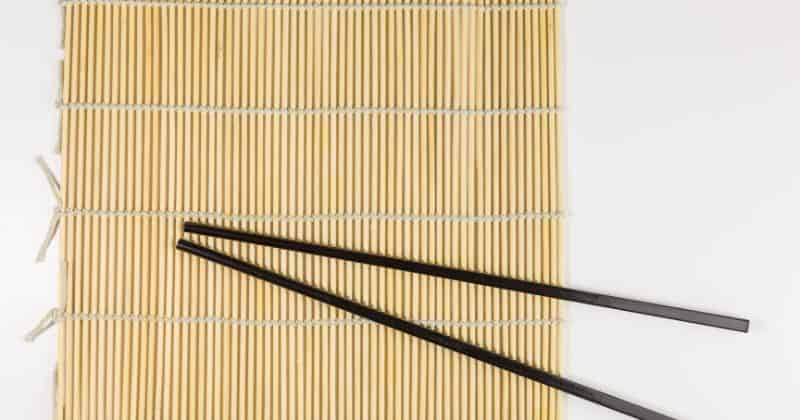
When choosing a sushi mat, look for one made of bamboo as it is natural, sustainable, and durable. Look for a mat that is around 9×9 inches and not too thick as this will make it easy to roll the sushi tightly and evenly. Beware of a plastic sushi mat that may be too thick as it can make rolling difficult.
You can also use plastic wrap in place of a sushi mat. This can be a good option if you are just starting and do not want to invest in a sushi mat yet. However, it may be harder to control the tightness of the roll as it is harder to shape the plastic wrap.
Sharp Knife
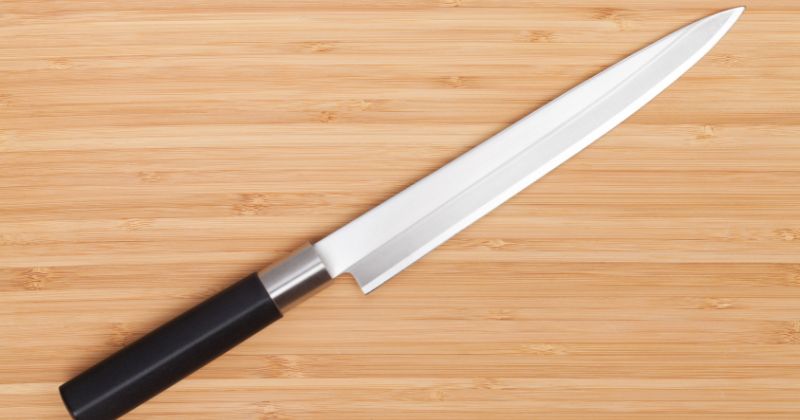
Look for a traditional Japanese-style knife such as a sushi knife or a hankotsu knife with a blade length of 6-8 inches and made of high-carbon stainless steel.
A choice for a sushi knife that can typically be found in a kitchen is a chef’s knife or a utility knife. These knives have a similar length and shape to a sushi knife and can be used to cut and shape ingredients for sushi. However, they may not be as sharp or precise as a traditional sushi knife.
Additionally, a sharp serrated knife can also be used for slicing fish and seafood. The key is to make sure the knife is sharp and suitable for slicing raw fish. (SO, if you’re not using seafood as fillings you can use any chef’s knife)
Wooden Sushi Rice Bowl
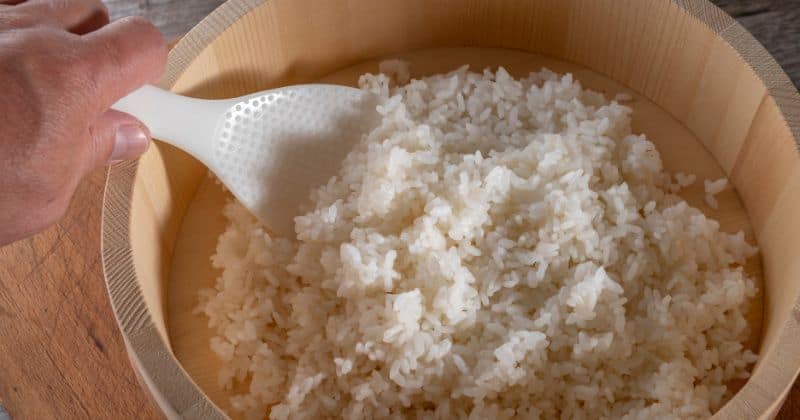
A sushi bowl is typically made of wood and is used to mix the rice, vinegar mixture, and seasonings. You can find wooden sushi bowls at most Asian markets or online retailers.
They are a great investment as they can be used for other types of dishes, such as salads or mixed grains.
Rice Cooker
You can use a stovetop or electric rice cooker to cook sushi rice. If you have an electric rice cooker, be sure to follow the instructions on properly cooking the rice.
If you don’t have a rice cooker, you can use a pot with a lid and cook the sushi rice on the stovetop. Be sure to keep an eye on it while cooking and adjust the heat so it does not stick to the bottom of the pot.
Rice Paddle
A rice paddle is a wooden utensil specifically designed for stirring and turning sushi rice. It is also used to spread and shape sushi rice on nori or other ingredients without smushing them.
You can usually find a rice paddle at kitchen supply stores, Asian markets, or online retailers. If you don’t have one on hand, you can use a wooden spoon in place of the paddle.
Sushi Making Kit
All-in-one packages includes sushi knife, rice bazooka, sushi mats, chopsticks, rice paddle, cucumber slices, nigiri maker, avocado slicer, dipping plate, sushi brush, e-book, and manekineko for lucks.
Sushi-making kits are a great option for those who want convenience and ease when making sushi at home.
They include all the essential tools you need in one package, which can save you money. This option is perfect for beginners, as they come with instructions and recipes that make it easy to learn how to make sushi.
These kits offer a convenient and cost-effective way to make sushi at home, without the need to purchase each tool separately.
However, the sushi-making kit is not for the long run, the quality of the tools won’t be as good as if you bought them separately.
Here is cost breakdown table for equipment:
| Equipment | Use for | Average Cost |
|---|---|---|
| Sushi Mat | Used for rolling sushi | $5-10 |
| Sharp Knife | Used for precision cutting and shaping of ingredients | $25-100 |
| Wooden Sushi Rice Bowl | Used for mixed rice and vinegar | $20-50 |
| Rice Cooker | Used for cooking sushi rice | $20-50 |
| Rice Paddle | Used for mixing and fluffing sushi rice | $5-10 |
| Rolling Tool | Used for shaping and compacting sushi rolls | $5-10 |
| Sushi Making Kit | Includes sushi mat, knife, recipe guide, and other tools | $30-50 |
Please note that the cost of equipment may vary depending on the brand, quality, and location.
Additionally, some of the equipment that is not specific to sushi making such as a plastic wrap, chef’s knife, utility knife, or serrated knife can be alternatives and can be found in most kitchens.
How to Make Sushi on a Budget
Now that you know the costs of the ingredients and equipment, let’s talk about how to make sushi on a budget.
Here are a few tips:
- Buy ingredients in bulk: If you plan to make sushi regularly, it can be more cost-effective to buy ingredients in bulk such as rice, nori, and vinegar.
- Opt for cheaper fillings: cucumber, carrots, bell peppers, lettuce, tofu, avocado, scallions, and egg omelet.
- Use frozen fish: Fresh fish can be expensive, so consider using frozen fish instead. It’s a great alternative and still provides a high-quality taste and texture.
- Use kitchen equipment you already have: You don’t need to buy expensive tools such as a sushi mat, knife, and wooden sushi rice bowl you can use kitchen equipment you already have such as a plastic wrap, chef’s knife, utility knife, or serrated knife.
- Make your sushi rice: Instead of buying pre-seasoned sushi rice, make your own by mixing rice vinegar, sugar, and salt with cooked rice.
- Be creative: You don’t have to stick to traditional sushi ingredients. Experiment with different fillings and seasonings to create unique and budget-friendly sushi rolls.
- Eating at all-you-can-eat sushi restaurants: can give you ideas for creating your sushi rolls. You can observe the presentation and taste of the different varieties to get a better understanding of what makes for a great sushi roll before you try to make it yourself without banking your bucks.
Final Thoughts
Sushi-making is a great way to enjoy delicious and nutritious meals at home. With the right ingredients, tools, and technique you can make sushi on a budget.
Don’t be afraid to get creative with fillings and seasonings, as this can help reduce costs while still delivering delicious results.
Keep in mind – to making is easy but mastering it takes dedication and patience. Have fun with it and don’t forget to enjoy the process! Good luck!

